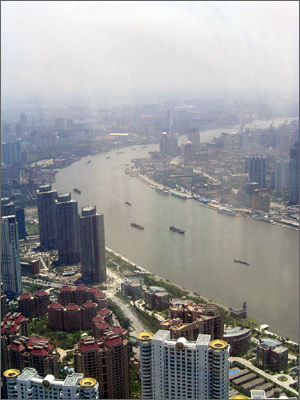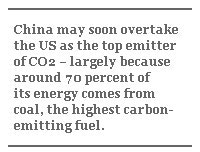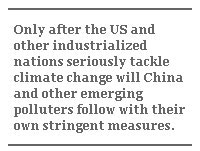China’s Plan for Global Warming: Wait for the US
China’s Plan for Global Warming: Wait for the US

Beijing says it will wait 'til the US caps its pollution
SINGAPORE: The scale and scope of Chinese pollution far outpaces what occurred in the US and Europe during their industrial revolutions. If it continues unchecked – and other big emerging economies follow a similar high-carbon growth path – the impact on the health of the planet could be catastrophic.
Climate change looms as a major and contentious topic for discussion by world leaders at the G8 summit hosted by Germany this week. And all eyes look to the world’s two leading emitters of carbon gases – the US and China – for a change in old ways.
China’s role as a leading contributor to global warming was underscored by the recent spurt in growth recorded by its already supercharged economy running essentially on coal-fired power. The unexpected rise of just over 11 percent in GDP for the first quarter means that the world’s most populous nation could overtake the US as the largest emitter of greenhouse gases this year or next, at least a year earlier than the International Energy Agency had predicted just six months ago.

Signals are mixed about whether China will play a proportionate role in the costly and politically difficult process of curbing the greenhouse gas emissions that are warming the planet. Global concerns aside, the Chinese government must balance continuing economic growth to provide jobs and social stability against the risk of degrading the natural resource base on which the future growth potential of the economy depends.
To sustain the world’s most populous nation, this resource base must include sufficient supplies of freshwater, arable land and breathable air. Excessive and wasteful use is seriously damaging and depleting China’s stock of natural assets. Urbanization and industrialization eat remorselessly into productive farmland. Noxious smog shrouds many Chinese cities. Much of northern and western China already suffers from chronic water shortages, which become even more serious as glaciers on the Qinghai-Tibetan plateau – a vital source of freshwater for about 750 million people in China, India and other parts of Asia – continue to melt.
China’s rise as a “dirty” power impels it to take effective action to cut emissions. But China has thus far taken its lead from the West, particularly the US. China, an economic powerhouse now, can argue that it has contributed less than 8 percent of the total emissions of carbon dioxide from energy use since 1850, while the US is responsible for 29 percent and Western Europe 27 percent, according to United Nations data.

Although China may soon overtake the US as the top emitter of CO2 – largely because around 70 percent of its energy comes from coal, the highest carbon-emitting fuel – its per-capita emissions remain far below those of the US and other wealthy countries. Beijing also points out that much of the growth in China’s emissions is to produce goods consumed in the West. However it is not just Chinese-made cheap goods that are going abroad, but air pollution as well. Blown by the jet stream, toxic pollutants reach the west coast of the US.
Like the US, China shies away from setting a mandatory cap on emissions. Both nations currently plan to rely on improvements in industrial efficiency to reduce greenhouse gases per unit of GDP. The European Union says this is far short of what is needed.
China is likely to consider a stronger target on emissions only after the US takes tougher measures. The Chinese government also expects other economic competitors in the developing world – among them, India, Brazil, Mexico and South Africa – to join the international negotiations and abide by any agreements.
Still, China’s position on global warming has evolved significantly in recent months. In the past, it adopted a stonewalling posture, blaming the US, Europe, Japan and other advanced economies for the mess and asserting that they should be responsible for cleaning it up.

In May, China was among the 120 nations in Bangkok attending the third meeting this year of the UN Intergovernmental Panel on Climate Change (IPCC). Its delegates drew some flak by raising questions and objections to some sections of the IPCC draft scientific report on the actions needed to combat global warming. Yet in the end, China endorsed the final report, which emphasizes that the world has the money and technology to fend off the worst impacts of climate change provided nations have the political will to act.
China also agreed in April with Japan to take part in negotiations on a framework for limiting global warming after 2012. This shift in position is a potentially important step in tackling global warming, showing that China is ready to engage in international talks on limiting emissions. The existing accord – the Kyoto Protocol signed in Japan a decade ago after two years of negotiations – only binds 35 developed nations and the European Community to cut CO2 and other greenhouse emissions by 5 percent below 1990 levels by 2012. The US and Australia refused to ratify the deal, arguing that it would damage their economies and that major carbon polluters in the developing world must also join.
China is shifting ground, realizing it must be a player if it wants to shape any post-2012 framework. Chinese scientists also warn that China will suffer badly from the adverse consequences of a warmer planet. The Chinese government’s first national assessment of global climate change warned bluntly in December that economic growth and development could be undermined. China must now decide whether to work within the UN framework to combat climate change or join the new US plan for the world's 15 biggest emitters to agree on ways and means of reducing greenhouse gases. In its most comprehensive response yet on climate change, China confirmed this week that it would cut greenhouse gas emissions by improving energy efficiency and applying advanced technology. In a report released Monday, China noted that its large population, status as a developing nation and reliance on coal all limit its ability to tackle climate change – and that wealthier industrialized nations should bear most of the burden.
China, like Europe, the US and many other countries, has a poor record in applying environmental policies that are economically and politically painful. The US, Japan, the EU, Australia and a number of other developed nations have offered substantial aid and technical assistance to China for emission control, which China has welcomed. China could do more to hasten the transfer of pollution-control technology, much of which belongs not to governments but to private-sector companies in the West. China could use some of its $1,200 billion in foreign-exchange reserves, by far the world’s largest, to buy proprietary equipment and know-how. This would also help reduce its trade surpluses with the US and Europe.

A more difficult, but essential, step is to advance market reform in China. Beijing controls energy prices, often keeping the costs to industrial and private users well below international levels to keep Chinese exports competitive and prevent consumer unrest. Cities compete to attract energy-intensive industries to provide jobs and revenue. Meanwhile, Chinese banks give easy credit to state-owned firms, rather than to more efficient businesses in the private sector.
China is already doing what Britain and some other European economies are doing or planning to do: install new nuclear power plants; expand hydro, wind, solar and other renewable energy; and run their energy-intensive industry and infrastructure more efficiently.
But only when the governments of the US and other big established polluters show that they are serious about tackling climate change can China and other large emerging polluters be expected to follow with their own stringent measures. The G8 summit would be a good place to begin this urgent task.
The writer, a former Asia editor of the International Herald Tribune, is an energy and security specialist at the Institute of South East Asian Studies in Singapore.